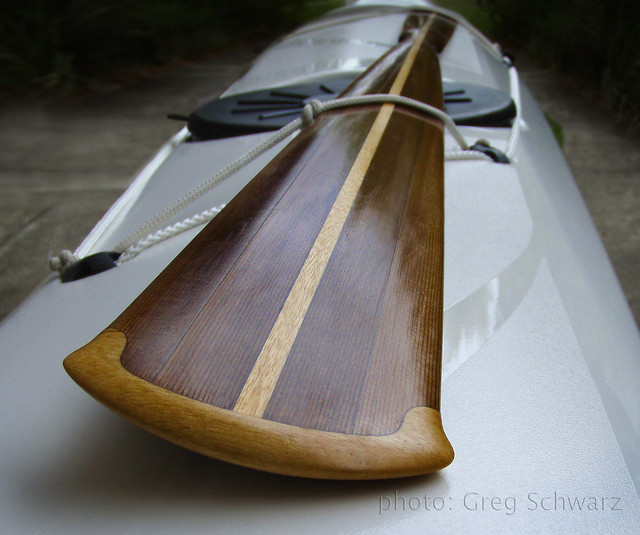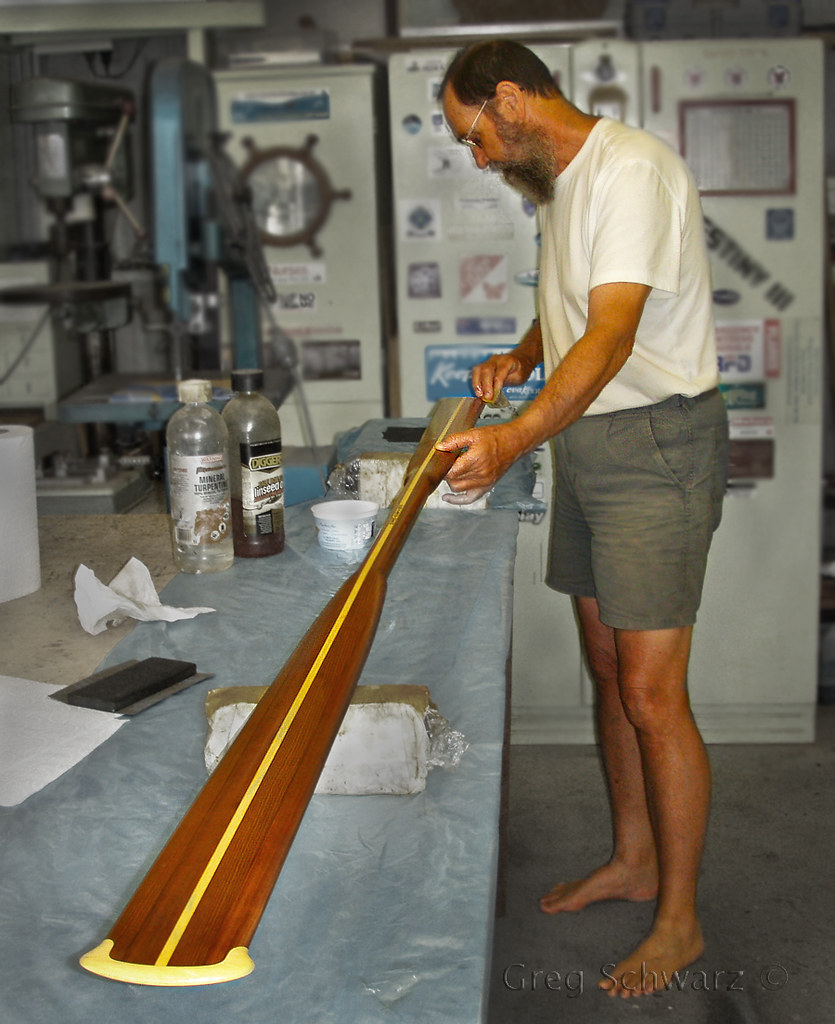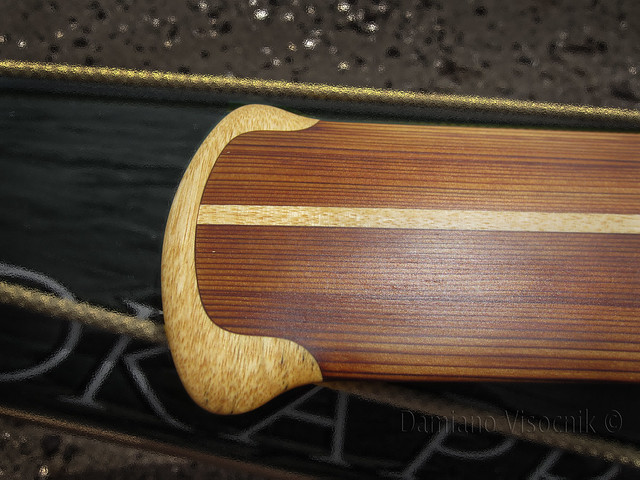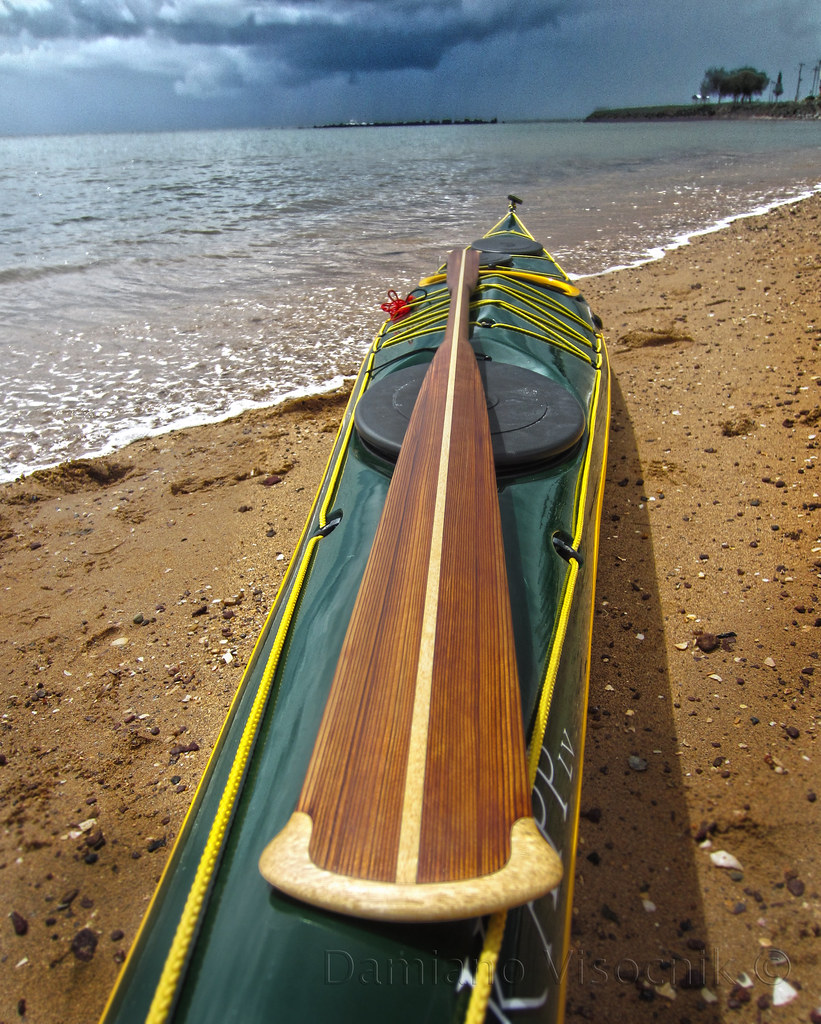
Because I carry a "Storm paddle" as my spare, I like to practice with it quite often so it's not a problem should I really need it one day.
I now enjoy the sliding stroke so much that sometimes I forget that I'm using the storm paddle. This, however, can be a problem (in my case anyway) if I suddenly need to brace, and I extend the paddle only to find my inboard hand empty! ( a butterfly roll is a handy skill to have here!)
I decided that if I made the end armour wider than the blade, I would have a built in "stop" to let me know that I had reached the end. Hydrodynamics is a pet interest of mine, so it appealed to me to shape the armour to optimise it's "end plate" effect, ie:- To help prevent the loss of water that could be used for lift, instead of escaping over the tip. This is by no means a new concept! Greenlanders, for centuries have been putting enlarged tips of bone and ivory on their paddles to protect the timber when smashing ice etc. But was that it's only purpose? As these people relied on their equipment for their survival, I'm inclined to think there is more to it. We now know that the Greenland paddle can be as efficient as a modern wing paddle when used correctly. As the son of a professional fisherman, I know that nothing is kept onboard that is not functional. So why the enlarged tips on some paddles ?….I decided to experiment.

I built a new storm paddle with widened tips. Although it was only 6.5mm (1/4") wider overall than the blade, it felt very smooth through the water. Everyone who tried the paddle made this comment unsolicited. It also appeared to give more lift, but this paddle had 1.5mm (1/16") finer edges on the blades than my normal blade, was that just the difference?

My paddling mate Steve needed a new paddle so I decided to expand on the theory and make the "flanges" larger, now 16mm (5/8") wider than the blade….We could always trim them down if they didn't work.
Steve likes fine edges on his paddles so I have yet to try this style of end armour on a thick edged blade, however, the paddle feels like it's another step up again in lift. Comparing it with a same sized, conventional paddle of mine, there is definitely an increase in lift and it is very smooth through the water.
My biggest concern was the entry into the water, but it is whisper quiet and again felt smooth. I had keep the tips of the "flange" quite fine for this reason, so I will have to get Steve to refrain from breaking ice with it… a real problem here in S.E. Queensland ;-)
I am keen to try even larger tips now! The sad part is that I now feel, all of my own paddles are obsolete!

last edited 21DEC
.

How intriguing! Looking forward to the review. :)
ReplyDeleteIt is beautiful! I'm wondering if that head will give you more power, stop paddle flutter, or if will tent to flutter. Looking forward to your review.
ReplyDeleteit appears that there is a PROBLEM with posting comments on this post.
ReplyDeleteFor some reason Blogger will no accept submissions if:
- you are logged into your Google account (Gmail) with the box: "Stay signed in" ticked -
The only way to comment is:
1) log out of your Google account
2) log in again WITHOUT ticking the "Stay signed in" box
3) submit your comment and follow the prompts on the submission form.
Gnarlydog News apologies for the inconvenience but there is not much that can be done about it short of changing blog providers.
I value your comments and I would love to hear from you.
Gnarlydog
oh that's beautiful... staying tuned ;-)
ReplyDeleteI want one!
ReplyDeleteLooks very nice:)
ReplyDeleteGnarlydog, I've been following your blog since starting kayaking last year. Love it! Thanks for posting all this great info and pix. Meantime, I also am about to make my second Aleut paddle. I'm thinking of a small hardwood perpendicular grained armor tip and was intrigued by your new one. Care to hazard a guess as to how this might function on an Aleut style stick?
ReplyDeletebartc, I believe that a similar style armour (bell shaped) as on the Hammerhead might not have the same advantages on an Aleut paddle as on a GP. A typical stroke with an Aleut paddle is not canted and the same hydrodynamics are not exerted on the tip of an Aleut as are on a GP. Of course these are just my speculations and only building one with those shaped tips and some testing will really give you the right answer. Put it this way: if the bell shaped ends don’t work it will take you very little to shave off the excess wood and bring the tips to a more traditional shape. Worth experimenting…
ReplyDeleteA real beauty!
ReplyDeleteNice paddle and just in time for me as I am about to make a new storm paddle myself.Your paddle is inspiring me to copy it too.
ReplyDeleteRegards, Steve